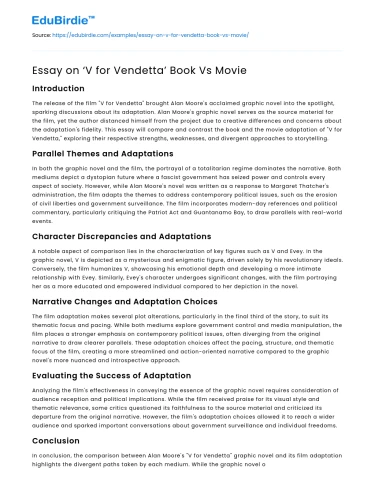Introduction
The release of the film "V for Vendetta" brought Alan Moore's acclaimed graphic novel into the spotlight, sparking discussions about its adaptation. Alan Moore's graphic novel serves as the source material for the film, yet the author distanced himself from the project due to creative differences and concerns about the adaptation's fidelity. This essay will compare and contrast the book and the movie adaptation of "V for Vendetta," exploring their respective strengths, weaknesses, and divergent approaches to storytelling.
Parallel Themes and Adaptations
In both the graphic novel and the film, the portrayal of a totalitarian regime dominates the narrative. Both mediums depict a dystopian future where a fascist government has seized power and controls every aspect of society. However, while Alan Moore's novel was written as a response to Margaret Thatcher's administration, the film adapts the themes to address contemporary political issues, such as the erosion of civil liberties and government surveillance. The film incorporates modern-day references and political commentary, particularly critiquing the Patriot Act and Guantanamo Bay, to draw parallels with real-world events.
Save your time!
We can take care of your essay
- Proper editing and formatting
- Free revision, title page, and bibliography
- Flexible prices and money-back guarantee
Character Discrepancies and Adaptations
A notable aspect of comparison lies in the characterization of key figures such as V and Evey. In the graphic novel, V is depicted as a mysterious and enigmatic figure, driven solely by his revolutionary ideals. Conversely, the film humanizes V, showcasing his emotional depth and developing a more intimate relationship with Evey. Similarly, Evey's character undergoes significant changes, with the film portraying her as a more educated and empowered individual compared to her depiction in the novel.
Narrative Changes and Adaptation Choices
The film adaptation makes several plot alterations, particularly in the final third of the story, to suit its thematic focus and pacing. While both mediums explore government control and media manipulation, the film places a stronger emphasis on contemporary political issues, often diverging from the original narrative to draw clearer parallels. These adaptation choices affect the pacing, structure, and thematic focus of the film, creating a more streamlined and action-oriented narrative compared to the graphic novel's more nuanced and introspective approach.
Evaluating the Success of Adaptation
Analyzing the film's effectiveness in conveying the essence of the graphic novel requires consideration of audience reception and political implications. While the film received praise for its visual style and thematic relevance, some critics questioned its faithfulness to the source material and criticized its departure from the original narrative. However, the film's adaptation choices allowed it to reach a wider audience and sparked important conversations about government surveillance and individual freedoms.
Conclusion
In conclusion, the comparison between Alan Moore's "V for Vendetta" graphic novel and its film adaptation highlights the divergent paths taken by each medium. While the graphic novel offers greater depth and complexity in its storytelling and characterization, the film succeeds in bringing the story to a broader audience and addressing contemporary political issues. Ultimately, both the book and the movie have their merits and limitations, contributing to the enduring significance and reception of "V for Vendetta" in popular culture.






 Stuck on your essay?
Stuck on your essay?

